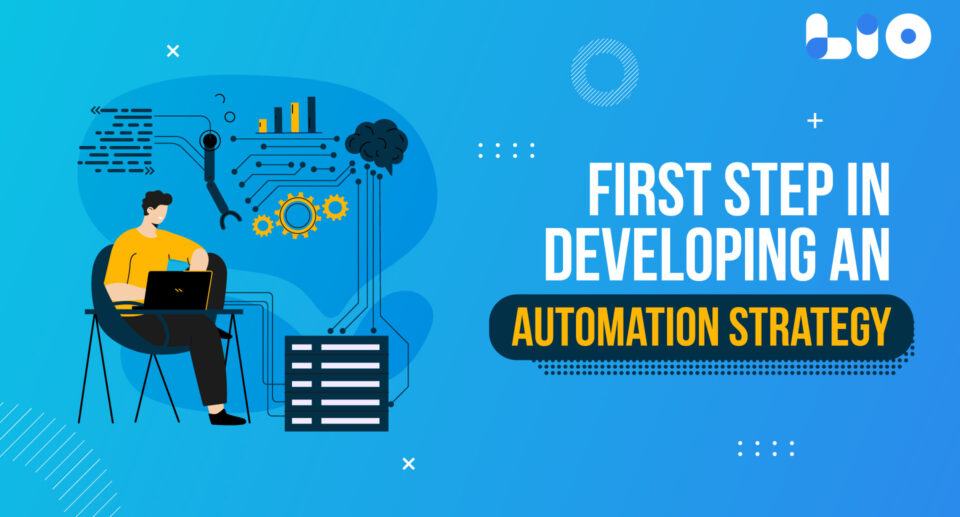The First Step in Developing an Automation Strategy: A Comprehensive Guide

Wondering what is the first step in developing an automation strategy? Read the article to know all about it and everything else about it.
In today’s business landscape, automation is essential to remain competitive and efficient. Developing an automation strategy can help organizations increase productivity, reduce costs, and improve customer satisfaction.
However, with so many different technologies and solutions available, it can be challenging to know where to start. In this article, we will explore the first step in developing an automation strategy, allowing you to lay the foundation for success.
First Step in Developing an Automation Strategy
Identify Business Processes

The first step in developing an automation strategy is to identify the business processes that are most suitable for automation.
Start by mapping out your business processes, from start to finish, and identifying any repetitive or manual tasks that could be automated. This could include tasks such as data entry, invoice processing, and customer service.
Evaluate Automation Technologies
Once you have identified the processes that are most suitable for automation, it’s time to evaluate the available automation technologies.
There are many different types of automation technologies, including robotic process automation (RPA), artificial intelligence (AI), and workflow automation. Consider the features, functionality, and costs of each technology to determine which solutions are best for your organization.
Determine Key Performance Indicators (KPIs)

Before implementing automation solutions, it’s essential to determine the key performance indicators (KPIs) that will be used to measure success.
KPIs could include metrics such as productivity, efficiency, accuracy, and customer satisfaction. By setting clear goals and KPIs, you can track the success of your automation strategy and make adjustments as necessary.
Create an Implementation Plan
Once you have identified the business processes, evaluated the available automation technologies, and determined the KPIs, it’s time to create an implementation plan.
This plan should include timelines, budgets, and resource allocation for implementing the selected automation technologies. It’s also essential to consider how the implementation will impact employees and to provide training and support as necessary.
Test and Refine
After implementing automation solutions, it’s essential to test and refine the processes continuously. This involves monitoring the KPIs and making adjustments to the automation technologies as necessary. It’s also important to obtain feedback from employees and customers to ensure that the automation solutions are meeting their needs.

Maximize Your Online Business Potential for just ₹79/month on Lio. Annual plans start at just ₹799.
How Lio can Help You?
To make your dreams come true of having a business of your own and managing it nicely, Lio App can help you big time. The app lets you keep all sorts of data together in a more organized manner. You can keep records, and create tables and lists while working solo or with a team.
The many features of Lio would help you with your retail business as you would be able to maintain all data on a track that you can use at any time. If you want to upload a document, then you can do that. Know the money transactions, cash inflow, profit and loss you are making, Udhaar, list of products, services, and even the teammates and clients that you have all in one place.
Step 1: Select the Language you want to work on. Lio on Android

Step 2: Create your account using your Phone Number or Email Id.

Verify the OTP and you are good to go.
Step 3: Select a template in which you want to add your data.

Add your Data with our Free Cloud Storage.
Step 4: All Done? Share and Collaborate with your contacts.

Conclusion
In conclusion, the first step in developing an automation strategy is to identify the business processes that are most suitable for automation.
This involves mapping out your processes, evaluating available automation technologies, determining KPIs, creating an implementation plan, and testing and refining the processes continuously. By following these steps, organizations can lay the foundation for a successful automation strategy, increase productivity, reduce costs, and improve customer satisfaction.
Frequently Asked Questions (FAQs)
What are the benefits of developing an automation strategy?
The benefits of developing an automation strategy include increased productivity, reduced costs, improved accuracy and consistency, and improved customer satisfaction. Automation can also free up time and resources, allowing employees to focus on more strategic initiatives.
What are the challenges of developing an automation strategy?
Some of the challenges of developing an automation strategy include identifying the processes that are most suitable for automation, evaluating the available technologies, determining KPIs, and ensuring that the implementation is successful. However, with proper planning and execution, these challenges can be overcome.
How can organizations ensure that the implementation of automation technologies is successful?
Organizations can ensure that the implementation of automation technologies is successful by creating a detailed implementation plan, providing employee training and support, and monitoring the KPIs and making adjustments as necessary. It’s also important to obtain feedback from employees and customers to ensure that the automation solutions are meeting their needs.
What are some common automation technologies used in businesses?
Common automation technologies used in businesses include robotic process automation (RPA), artificial intelligence (AI), workflow automation, chatbots, and machine learning.
Each technology has its unique features and benefits, and organizations should evaluate their specific needs and goals to determine which solutions are best for their operations.
How can organizations ensure that employees are prepared for automation?
Organizations can ensure that employees are prepared for automation by providing training and support throughout the implementation process. This includes educating employees on the benefits of automation, how it will impact their job roles, and providing training on new technologies and processes.
It’s also important to involve employees in the automation strategy development process, so they feel like they have a stake in the success of the initiative.
Is it necessary to automate all business processes?
No, it’s not necessary to automate all business processes. Organizations should identify the processes that are most suitable for automation based on their business goals, resource allocation, and available technologies.
Some processes may not be suitable for automation, or the costs of automation may outweigh the benefits. It’s important to evaluate each process on a case-by-case basis to determine which processes are most suitable for automation.







